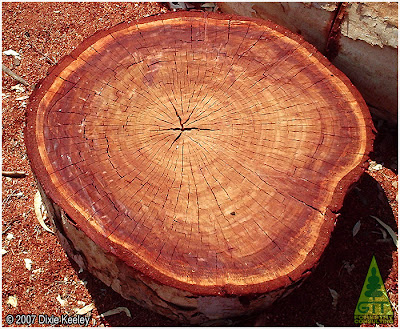Making charcoal with Eucalyptus "Mahogany"? Shit happens.
Gustavo Iglesias Trabado

GIT Forestry Consulting - Consultoría y Servicios de Ingeniería Agroforestal - www.git-forestry.com - EUCALYPTOLOGICS
Seasonal colour changes can appear in the foliage of some ornamental Eucalyptus, as we have seen. But these variable trees also show some colour changes when we consider one of the principal products they are cultivated for: Eucalyptus timber.
However, in this case of Eucalyptus wood, colour variation is not seasonal. Or it should not be! But it can be seen when logs are seasoning. A wide variety colours is possible if we travel Australia up and down jumping from log to log of different Eucalyptus species, finding a range from white or very pale timbers to dark rich coloured ones.
Overseas, where the total number of cultivated eucalypt species in each area of the world is more limited, and where the number of those becoming sizeable timber resources is more limited even, chances to observe different colours depend on the main industrial lines processing such timbers. The desired physical and chemical properties in timber can be quite variable depending on the final use. Pale timbers with an attractive cellulose/lignin ratio and needing as little bleaching as possible are preferred by cellulosic and paper processors. Then, as it normally happens, species with high growth rates for a given climate, able to be managed in as short rotations as possible, tend to be the most common type of eucalypt timber wherever such industries develop. Still, many of these species, if cultivated properly (suitable genetic background + clearwood management regimes) can yield high quality products for alternative industrial lines that make eucalyptus wood visible as woodcraft art.
However, some other Eucalyptus timbers can have industrial attractive precisely because of those timber properties that make them less preferred for cellulose manufacture: very heavy timbers, interesting grains, suboptimal cellulose/lignine ratios, and tannin rich coloured heartwoods. A broad range of them are, again, available in Australian native forests and more recent specialty plantations. But some, also overseas.
One of these several high quality timbers is generically known as Red Gum. One of the more widely known species able to yield this type of timber is Eucalyptus camaldulensis (ex E. rostrata), the River Red Gum or "Red Eucalypt" (Eucalipto Rojo). And of course, its common name makes sense once you see a piece of timber.
Overseas, where the total number of cultivated eucalypt species in each area of the world is more limited, and where the number of those becoming sizeable timber resources is more limited even, chances to observe different colours depend on the main industrial lines processing such timbers. The desired physical and chemical properties in timber can be quite variable depending on the final use. Pale timbers with an attractive cellulose/lignin ratio and needing as little bleaching as possible are preferred by cellulosic and paper processors. Then, as it normally happens, species with high growth rates for a given climate, able to be managed in as short rotations as possible, tend to be the most common type of eucalypt timber wherever such industries develop. Still, many of these species, if cultivated properly (suitable genetic background + clearwood management regimes) can yield high quality products for alternative industrial lines that make eucalyptus wood visible as woodcraft art.
However, some other Eucalyptus timbers can have industrial attractive precisely because of those timber properties that make them less preferred for cellulose manufacture: very heavy timbers, interesting grains, suboptimal cellulose/lignine ratios, and tannin rich coloured heartwoods. A broad range of them are, again, available in Australian native forests and more recent specialty plantations. But some, also overseas.
One of these several high quality timbers is generically known as Red Gum. One of the more widely known species able to yield this type of timber is Eucalyptus camaldulensis (ex E. rostrata), the River Red Gum or "Red Eucalypt" (Eucalipto Rojo). And of course, its common name makes sense once you see a piece of timber.
Curiously, this was one of the earliest eucalypts cultivated outside of Australia (as early as the early 1800's) and is today one of the commonest in almost any arid or semi-arid climate around the world with a Mediterranean tendence and frequent droughts, be it in Europe, California, South America, Africa or Asia.
Much of the final use for this plantation timber cannot match well the highest preferences of cellulosic industries if other eucalypt timbers are easily available, and the most obvious alternative industrial uses have then to do with sustainable supplies of firewood or charcoal, or, in these days of climatic change frenziness, environmentally friendly biomass for "green fuel".
However, one wonders, if there are or there are not enough red river gums within the half a million hectares (!!) of plantations in Spain, Morocco and Italy able to supply logs of dimension and stability enough as to yield other products.
All in all, isn't high quality handcrafted furniture with "Eucalyptus Mahogany" much more appealing for a log than ending up as charcoal?
© 2007 Gustavo Iglesias Trabado. Please contact us if you want to use all or part of this text and photography elsewhere. We like to share, but we do not like rudeness.
Subscribe to receive EUCALYPTOLOGICS via RSS
© 2007 Gustavo Iglesias Trabado. Please contact us if you want to use all or part of this text and photography elsewhere. We like to share, but we do not like rudeness.






No comments:
Post a Comment